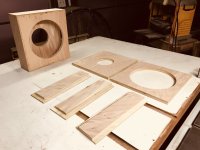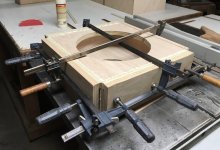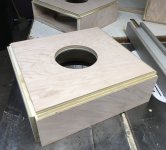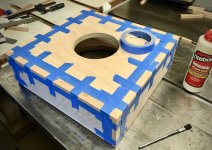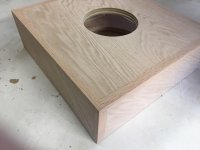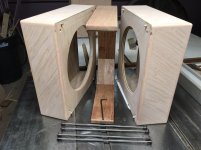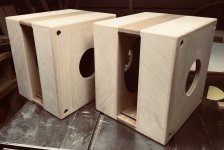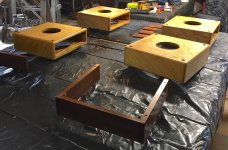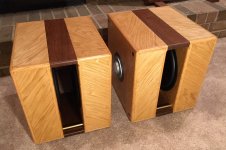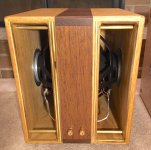Jazzman53
Member
- Thread Author
- #1
Hi All,
I'm pleased to share my latest RiPol sub project below. These use the same Peerless SLS 12 woofers as my previous ones, but are 1/2" smaller in height/depth and the plywood grain directions are angled for a book-matched look -- much prettier!
Not everyone is familiar with RiPol subs so I will first give my take on what they are and how they work.
The configuration was patented by German speaker builder Axel Ridtahler, hence the name "RiPol" is short for a "Ridtahler dipole".
A RiPol is basically a compact, folded-baffle dipole with two woofers in opposing push/push arrangement. Its radiation pattern isn't the classic dipolar figure-8, but cardioid shaped with a pronounced frontal lobe, and similar off-axis nulls.
Perhaps the RiPol's most unique feature is its effect on the woofers' resonance. Every woofer has a natural resonance which is typically loud and certainly undesirable because it's a distortion that isn't in the music.
Conventional sub enclosures force the woofer's resonance higher than it's resonance in free air (more so in a smaller box, less so in a bigger or ported box, but always up/never down).
A RiPol enclosure lowers the woofer's resonant frequency by about 10Hz, which not only allows it to play lower but has a profoundly good effect on tonal quality.
Let's say we are using woofers that resonate at 30Hz in free air:
- A conventional enclosure forces the resonance upward, within the audible bass band. And if the music contains any energy at that frequency, the resonance will be excited and its distortion will be heard.
- A RiPol forces the woofers' resonance downward about 10Hz (down to 20Hz in this case). Most music contains little or no energy down at 20Hz, in which case the resonance would not be excited so would not occur. And even if the music does contain energy that low, 20Hz is at the threshold of human hearing, so you might feel it but you wouldn't actually hear it as a tone.
Another advantage is the dipolar off-axis nulls, which tends not to excite room resonances that can render the bass sluggish and inarticulate, or even produce the dreaded "one note boom".
Dipolar bass isn't very efficient so I always recommend a pair of RiPol's rather than just one, and they don't pressurize the room in the same way as conventional subs. Not everyone likes them because they don't hit you in the chest like a sledge hammer... but I LOVE them. Their sound arises from nowhere and recedes back to nowhere-- wonderful for jazz, and simply the cleanest, most unobtrusive bass I've ever experienced.
Modak Akustik in Germany markets a similar RiPol sub which uses the same Peerless SLS woofers.
A Product Review of this sub by 6-Moons Audio includes the following statement:
"For music-first listeners who prioritize speed, articulation and enunciated clarity, it's the long awaited messiah."
Srajan Ebaen, 6moons.com
I share that sentiment, and I will share my drawing & parts list with anyone who asks-- just PM me an email address.
**************************************************************************************
Build info:
The woofer cabs are 3/4 red oak plywood with oak edge members inserted and rounded over, which looks much better than exposed plywood edges but is a LOT MORE work. The center section is solid brown oak, indexed to the cabs with oak dowel pins. The cabs and center section are held together with all-thread rods and cap nuts.
The light-colored oak cabs were oil stained with a mixture of 1/3 golden oak, 2/3 natural, and a bit of powdered turmeric root added for a yellowish tint. The darker oak center section was oil stained with red oak, for contrast. The finish is sprayed-on coats of clear satin polyurethane with a #320 sanding step between coats.
Photo 1: Rabbited plywood cab pieces self-locate and bank together for gluing.
Photo 2: Cab glued and clamped.
Photo 3: Cab edges notched on the table saw to accept the red oak edge members.
Photo 4: Mitered edge members held in place with painter's tape while the glue sets.
Photo 5: Cab with edge members installed & sanded flush.
Photo 6: Three-piece assembly (woofer cabs + center section).
Photo 9: RiPol enclosures assembled & edges rounded-over.
Photo 8: Details stained & satin poly clear coated.
Photo 9: Completed sub pair with Peerless SLS 12 woofers installed.
Photo 10: Back view.
Enjoy!
Charlie in Savannah, GA
I'm pleased to share my latest RiPol sub project below. These use the same Peerless SLS 12 woofers as my previous ones, but are 1/2" smaller in height/depth and the plywood grain directions are angled for a book-matched look -- much prettier!
Not everyone is familiar with RiPol subs so I will first give my take on what they are and how they work.
The configuration was patented by German speaker builder Axel Ridtahler, hence the name "RiPol" is short for a "Ridtahler dipole".
A RiPol is basically a compact, folded-baffle dipole with two woofers in opposing push/push arrangement. Its radiation pattern isn't the classic dipolar figure-8, but cardioid shaped with a pronounced frontal lobe, and similar off-axis nulls.
Perhaps the RiPol's most unique feature is its effect on the woofers' resonance. Every woofer has a natural resonance which is typically loud and certainly undesirable because it's a distortion that isn't in the music.
Conventional sub enclosures force the woofer's resonance higher than it's resonance in free air (more so in a smaller box, less so in a bigger or ported box, but always up/never down).
A RiPol enclosure lowers the woofer's resonant frequency by about 10Hz, which not only allows it to play lower but has a profoundly good effect on tonal quality.
Let's say we are using woofers that resonate at 30Hz in free air:
- A conventional enclosure forces the resonance upward, within the audible bass band. And if the music contains any energy at that frequency, the resonance will be excited and its distortion will be heard.
- A RiPol forces the woofers' resonance downward about 10Hz (down to 20Hz in this case). Most music contains little or no energy down at 20Hz, in which case the resonance would not be excited so would not occur. And even if the music does contain energy that low, 20Hz is at the threshold of human hearing, so you might feel it but you wouldn't actually hear it as a tone.
Another advantage is the dipolar off-axis nulls, which tends not to excite room resonances that can render the bass sluggish and inarticulate, or even produce the dreaded "one note boom".
Dipolar bass isn't very efficient so I always recommend a pair of RiPol's rather than just one, and they don't pressurize the room in the same way as conventional subs. Not everyone likes them because they don't hit you in the chest like a sledge hammer... but I LOVE them. Their sound arises from nowhere and recedes back to nowhere-- wonderful for jazz, and simply the cleanest, most unobtrusive bass I've ever experienced.
Modak Akustik in Germany markets a similar RiPol sub which uses the same Peerless SLS woofers.
A Product Review of this sub by 6-Moons Audio includes the following statement:
"For music-first listeners who prioritize speed, articulation and enunciated clarity, it's the long awaited messiah."
Srajan Ebaen, 6moons.com
I share that sentiment, and I will share my drawing & parts list with anyone who asks-- just PM me an email address.
**************************************************************************************
Build info:
The woofer cabs are 3/4 red oak plywood with oak edge members inserted and rounded over, which looks much better than exposed plywood edges but is a LOT MORE work. The center section is solid brown oak, indexed to the cabs with oak dowel pins. The cabs and center section are held together with all-thread rods and cap nuts.
The light-colored oak cabs were oil stained with a mixture of 1/3 golden oak, 2/3 natural, and a bit of powdered turmeric root added for a yellowish tint. The darker oak center section was oil stained with red oak, for contrast. The finish is sprayed-on coats of clear satin polyurethane with a #320 sanding step between coats.
Photo 1: Rabbited plywood cab pieces self-locate and bank together for gluing.
Photo 2: Cab glued and clamped.
Photo 3: Cab edges notched on the table saw to accept the red oak edge members.
Photo 4: Mitered edge members held in place with painter's tape while the glue sets.
Photo 5: Cab with edge members installed & sanded flush.
Photo 6: Three-piece assembly (woofer cabs + center section).
Photo 9: RiPol enclosures assembled & edges rounded-over.
Photo 8: Details stained & satin poly clear coated.
Photo 9: Completed sub pair with Peerless SLS 12 woofers installed.
Photo 10: Back view.
Enjoy!
Charlie in Savannah, GA

